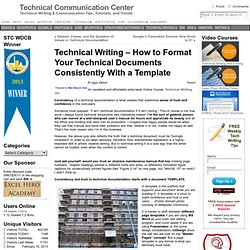

7 Tips To Improve the Format of Technical Documents. A document can be saved, retrieved, published, circulated, discussed, consulted, and archived. Documents can take the form of specifications, procedures, memoranda, histories, or letters of complaint. Software Development (SDLC) Templates Even source code files are documents. A document can be used to inform others of your great new product idea, or to help defend yourself in a lawsuit. Most importantly, a document can be used as a contract--a record of an agreement between people about what shall be done, and the terms under which it shall be done. Like a good Web page or a good roadmap, a good document contains meta-information--information that helps you understand things about the document itself, rather than its content. Here are a few of the essentials in creating a document that will help to speed things up, rather than slow things down.
Technical Template Dangers. Had a couple random thoughts about document templates.

I have spent a lot of time over the years writing technical docs (specs, test plans, etc) and that includes creating templates, using templates, not using templates, etc. Virtues of templates: Help you remember things to think about while writing a docAllows an organization to learn by adding stuff to the template that was important but missed in the pastLets you focus on content rather than style (especially helpful when using something heavyweight like Word) Dangers of templates: I’m not really pro- or anti- template, just listing some thoughts.
In all cases, the goal should be clarify and illuminate the subject. Technical Writing - How to Format Your Technical Documents Consi. © Ugur Akinci An excellent and affordable entry-level Online Course: Technical Writing 101 Consistency of a technical documentation is what creates that subliminal sense of trust and confidence in the end-users.

Someone once quipped: “it ain’t technical documentation if it ain’t boring.” This of course is not true since I always found technical documents very interesting indeed. I’m the sort of geekish person who can marvel at a well-designed user’s manual for hours and appreciate its beauty and all the effort and thinking that went into its production. However, the above quip also reflects the truth that a technical document must be “boringly consistent” in order to be taken seriously. Just ask yourself: would you trust an airplane maintenance manual that has missing page numbers; chapter headings printed in different fonts and sizes; or differently formatted figure captions for consecutively printed figures (like “Figure 2-14″ on one page, but “IMAGE 15″ on next)? User Guides Tips: Making Difficult Subjects Easy to Understand.
User Guide Templates You can change this perception by making difficult subjects easier to understand and ensure that the guides assist the user with the task at hand. Well-written documentation should be easy to: Read Understand Access To do this, when you are writing you need to know: Who is the target audience? Define each of these during the planning process. Statement of Work Template To achieve this goal, first outline your requirements.
The role of Technical Writers is to work with users, customer support and the Development Dept. to ensure that the user s perspective is captured in the final document. Those writers involved from the start will understand the system better, making it easier to plan and write the required documentation. Document Planning Document planning includes designing the structure and form of the material, as documentation may need to be produced for: Online Help Hard copy manuals Quick reference guides Decide what works best. Technical Documentation Sources. Development of Templates for Technical Documentation / Software. ▪Less is more: It’s vital to have a clear design that encourages a focus on the content and that doesn’t distract, both for the reader and writer of technical documentation. The key rule is: Less is more. Having a small number of well-thought-out styles is much more practical than having a plethora of individual styles for every exception you can think of.
▪Semantic styles: As another basic principle, styles are never named according to their visual appearance but according to the content of the text they’re to be applied to. Therefore, for example, a style will never be named “ArialBold10Point” but “emphasis” or “menu item” instead.This constantly forces the author to reflect on the structure of the document, and it’s the key requirement for structured authoring, such as authoring with XML DITA, for example. ▪Easy to change: All styles are organized hierarchically. ▪Easy to remember: Hot keys (shortcuts) are defined for the most frequently used styles.